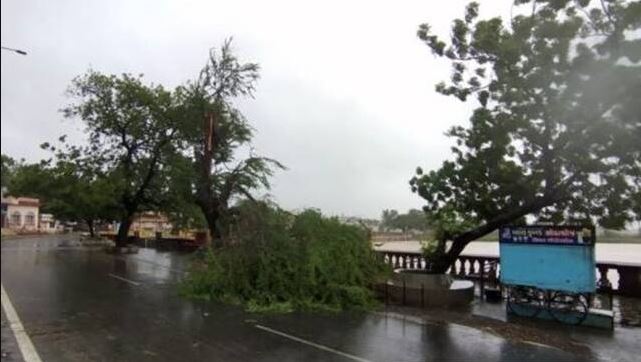Weather-related disasters used to be a permanent fixture in our annual calendar. With one of the longest coastlines in the world, India has always been vulnerable to cyclones. Many have vivid memories of large-scale damage caused by these cyclones: Dilapidated villages, people queuing up for medicines and water-clogged roads often bring with them a disturbing recollection of climate-induced tragedies. My mother often recalls how she, along with her other siblings, used to run to the terrace when they heard the sounds of helicopters throwing packets of bread, powdered milk and biscuits during floods. And yes, some intellectuals from the past were used to justifying this under the garb of rural romanticism. In parts of Northern Bihar, there still are folktales and flood poems that speak to how used to the idea of devastating floods people have gotten in light of government apathy. However, there has been a transformation in the disaster-management regime that has gone unnoticed.
Biparjoy cyclone: My mother has memories of the despair caused by extreme weather events – future generations will not.
We must talk about the phenomenal transformation of disaster management regime under PM Modi.
I write for @IndianExpress https://t.co/bg2AtNVaDo— Dr. Guru Prakash Paswan (@IGuruPrakash) June 20, 2023
There is renewed political will in the establishment to deal with these challenges and save people who are affected by these disasters, who are often unseen in the larger climate narrative.
The National Disaster Management Plan (NDMP), envisioned six years ago, represents a significant achievement in India’s disaster-management strategy. Its statement posits that it will furnish an all-encompassing structure for the management of disasters across various levels — national, state, district, and local. The objective is to augment India’s capacity to withstand disasters by prioritising diverse facets such as prevention, preparation, response, mitigation, and recovery. The NDMP has a comprehensive and interdisciplinary approach to disaster management, which prioritises the involvement and engagement of local communities.
Between 2014 and 2023, a series of Doppler Weather Radars were installed throughout the country. These devices have been instrumental in gathering data on severe weather events and have proven to be valuable tools for disaster-management agencies. With them, detailed weather forecasts and recommendations for all regions of the country can be provided, with a focus on the block level. Over the past five years, there has been an extraordinary improvement in the precision of predictions for various forms of severe weather, including but not limited to intense precipitation, fog, extreme temperatures, and thunderstorms, with an increased accuracy of 40 per cent to 50 per cent.
The recent red alerts issued in eight districts impacted by the Biparjoy storm within a condensed time frame — which led to the evacuation of numerous citizens and livestock to secure locations — serve as notable illustrations of effective disaster management.
Planning, efficient coordination, and clear communication channels between the central and Gujarat government resulted in achieving minimal human casualties during the Biparjoy cyclone in Gujarat. Earlier, the United Nations commended India’s policy of zero casualties and the Indian Meteorological Department’s precise forecasting, which resulted in a substantial reduction in the loss of human life during Cyclone Fani in the year 2019.
The Modi government has systematically promoted the utilisation of advanced technology and a proactive approach, as opposed to a reactive one, in addressing natural disasters with the implementation of early warning systems, prevention, mitigation and preparedness-based disaster management. Previously, the Indian Meteorological Department (IMD) provided a forecast of rainfall and resulting floods three days in advance. It has now extended this forecast to five days in advance, allowing for additional time to coordinate rescue efforts. Furthermore, there have been directives to extend the forecast to seven days in advance by the upcoming year.
The government has also provided incentives through the practice of conferring Subhash Chandra Bose Aapda Prabandhan Puraskar upon individuals and entities that have made remarkable contributions in the domain of disaster management. This has undoubtedly served as a source of motivation for individuals and organisations engaged in the sphere.
The financial outlay to State Disaster Response Force (SDRF) has almost quadrupled from Rs 35,858 crore in 2005-06 to Rs 1,04,704 crore in 2014-2015 to 2022-23.
Additionally, NDRF disbursement has tripled from Rs 25,000 crore to Rs 77,000 crore. This has resulted in the federal government and individual states being allocated more money for the preparation and response to natural disasters and for rebuilding once they have occurred. In 2021, the central government set aside Rs 16,700 crore for the National Disaster Mitigation Fund, while the State Disaster Management Authority (SDMF) set out Rs 32,000 crore for disaster prevention.
It is our collective duty to ensure that no child in future generations is excited by the idea of helicopters throwing food on terraces and distress literature emerging to intellectualise controllable calamities.
The writer Guru Prakash is national spokesperson, BJP

